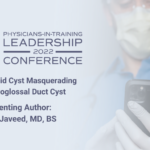Abstract | April 6, 2022
Large Dermoid Cyst Masquerading as a Thyroglossal Duct Cyst
Learning Objectives
- Describe imaging findings of a thyroglossal duct cyst;
- Describe imaging findings of a dermoid cyst;
- Discuss differences on CT and Ultrasound between a dermoid cyst and thyroglossal duct cyst.
Introduction: Dermoid cysts are rare, benign congenital tumors that develop due to abnormal fusion of ectodermal and mesodermal cell lines. On histology, these growths are lined by stratified squamous epithelial cells and typically contain adnexal structures including sebaceous glands, sweat glands, and hair follicles, which can help distinguish them from epidermoid cysts. More complex dermoid cysts will also contain cartilage, bone, and fat. Classically, 70% of dermoid cysts are discovered in children 5 years and younger and 1-7% develop in the head and neck area. Most often they are seen in the periorbital, lateral eyebrow location. Other areas of presentation include over the frontal and occipital areas as well as the upper and lower eyelid. They usually present as firm subcutaneous nodules that appear pearly, fleshcolored, and dome-shaped without pulsatility. Dermoid cysts present less commonly in adults and can easily be overlooked when presenting in an uncommon location such as, in our case, over the midline neck.
Dermoid cysts of the head and neck carry with them the dangerous risk of intracranial extension. Expansion or rupture of the contents of these cysts into the subarachnoid space or cerebral ventricles can lead to encephalomeningitis or seizures. Standard surgical management is direct or endoscopic simple excision of the dermoid cyst. However, in the case presented, a Sistrunk procedure was performed as suspicion of thyroglossal duct cyst was greater. This involves removal of the mass as well as the middle third of the hyoid bone and a portion of the thyroglossal tract posterosuperior to the hyoid.
Case Presentation: A generally healthy 22 year old male was being worked up in an outpatient setting for a neck mass that had been present for the last two years which he had been informed was a thyroglossal duct cyst. The patient denied radiation exposure or a family history of thyroid malignancy. He denied chest pain, palpitations, weight changes, heat or cold intolerance, or generalized weakness. On the physical exam, the patient was in no acute distress. A visible and protruding midline neck mass was seen without deviation of the trachea. The patient’s neck was supple with normal range of motion. His TSH and T4 levels were normal, and his thyroid peroxidase antibody was negative. An ultrasound was performed revealing a complex cystic lesion seen in the midline measuring 4.8 x 4.5 x 3.6 cm that showed multiple echogenic internal foci suggestive of fat globules. On a CT Neck with contrast, there was a wellcircumscribed lobular mass in the right anterior paramedian/ epicenter infrahyoid position. Dimensions were approximately 50 x 39 x 32 mm. There were internal septations and nodular hypodense/fat density foci. The walls were slightly thickened. There was no definite ectopic thyroid tissue and there were some indistinct submandibular lymph nodes.
Final Diagnosis: Large Dermoid Cyst midline neck
Management: The patient then underwent a fine needle aspiration biopsy of the mass that was negative for malignancy and showed neutrophils, histiocytes, and squamous cells, suggestive of a thyroglossal duct cyst. The procedure went without complications. A Sistrunk procedure was performed for cyst removal and a gross specimen was submitted to pathology. The final diagnosis made from histology was a 5 cm dermoid cyst.

